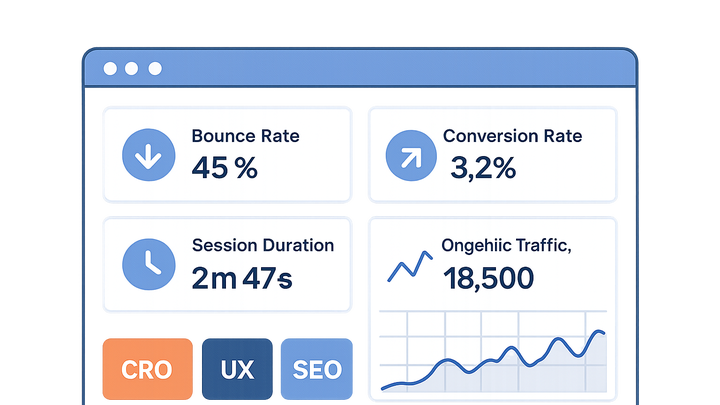Published on 2025-06-29T19:57:52Z
What Is Analytics? Examples for CRO, UX & SEO
Analytics refers to the systematic collection, measurement, and interpretation of website data to guide improvements in conversion rate optimization (CRO), user experience (UX), and search engine optimization (SEO). Through tracking metrics like bounce rate, session duration, and organic traffic sources, analysts can identify user behavior patterns and uncover friction points. This data-driven approach ensures that design changes and content strategies are based on real user interactions, rather than guesswork. In the context of CRO and UX, analytics help pinpoint where users drop off, what engages them, and how to streamline conversion paths. For SEO, analytics illuminate keyword performance, backlink impact, and visibility trends, empowering marketers to adjust their strategies. Platforms like prevue.me automate much of this process, offering actionable critiques and prioritized recommendations to boost lead generation, accessibility, and overall site effectiveness.
Analytics
Analytics is the practice of collecting, measuring, and interpreting data to improve conversion rates, user experience, and SEO on websites.
Importance of Analytics in CRO/UX/SEO
Analytics serves as the foundation for data-driven decisions in conversion rate optimization, user experience, and search engine optimization. By systematically collecting and interpreting user interaction data, teams can identify pain points, measure engagement, and validate hypotheses before implementing changes.
-
Driving conversion rate optimization
Analyzing metrics like conversion funnels, landing page performance, and form submissions helps uncover opportunities to increase lead generation and sales.
-
Funnel analysis
Tracks how users progress through key steps, highlighting drop-off points for targeted improvements.
-
Form completion rate
Measures how many visitors complete forms, indicating friction in data entry or usability issues.
-
-
Enhancing user experience
User behavior data such as session duration, heatmaps, and click paths reveal obstacles in navigation and content clarity.
-
Session duration
Indicates overall engagement and whether content captivates or loses visitors.
-
Heatmaps
Visualizes user attention areas, showing where to optimize layout and calls to action.
-
-
Boosting seo performance
Organic traffic trends and keyword analytics guide content strategy, link-building, and on-page optimization efforts.
-
Organic traffic source
Identifies which search queries and referring domains drive visitors.
-
Click-through rate (ctr)
Shows how compelling meta titles and descriptions are in search results.
-
Key Metrics in Website Analytics
Selecting the right metrics is essential for understanding site performance. Each metric provides unique insights into user behavior and site health.
-
Bounce rate
The percentage of single-page sessions, indicating how often users leave after viewing only one page.
-
Conversion rate
The ratio of visitors who complete a desired action to total visitors, essential for measuring CRO success.
-
Session duration
Average length of user sessions, reflecting engagement and content relevance.
-
Organic traffic
Number of visitors arriving via search engines, a key indicator of SEO effectiveness.
How prevue.me can help?
prevue.me streamlines analytics by automating data collection on crawl without trackers. Analysis, and actionable feedback specifically tailored for CRO, UX, SEO, and accessibility improvements.
-
No tracker, simple crawling on a public URL
Seamlessly integrates with your website to gather comprehensive metrics without manual setup.
-
Easy integration
No need for setup, all you need is publicly accessible URL
-
Unified dashboard
Centralizes CRO, UX, SEO, and accessibility data for holistic insights.
-
-
Actionable critiques
Generates prioritized recommendations based on your site's analytics, highlighting the most impactful optimizations.
-
Cro suggestions
Offers improvements like form redesigns or call-to-action adjustments to boost conversions.
-
Seo insights
Recommends keyword optimizations, meta tag enhancements, and backlink strategies.
-
Accessibility checks
Identifies contrast issues, missing alt text, and other accessibility barriers.
-
-
Prioritization of recommendations
Assigns priority levels based on potential impact and ease of implementation, helping teams focus on high-value tasks first.
-
High-priority fixes
Critical issues that can significantly improve conversion and usability.
-
Low-priority tasks
Minor adjustments that enhance performance over time.
-
Best Practices for Analytics Implementation
Effective analytics depend on clear goals, accurate data, and continuous refinement.
-
Define clear goals
Establish specific, measurable objectives (e.g., increase form submissions by 20%) to guide analytics tracking.
-
Ensure data quality
Regularly audit your setup to prevent tracking errors, duplicate events, and inaccurate reports.
-
Regular reporting & analysis
Schedule periodic reviews of analytics dashboards to detect trends, anomalies, and opportunities.
-
Iterative optimization
Use insights to run experiments, test changes, and refine strategies based on real user feedback.
